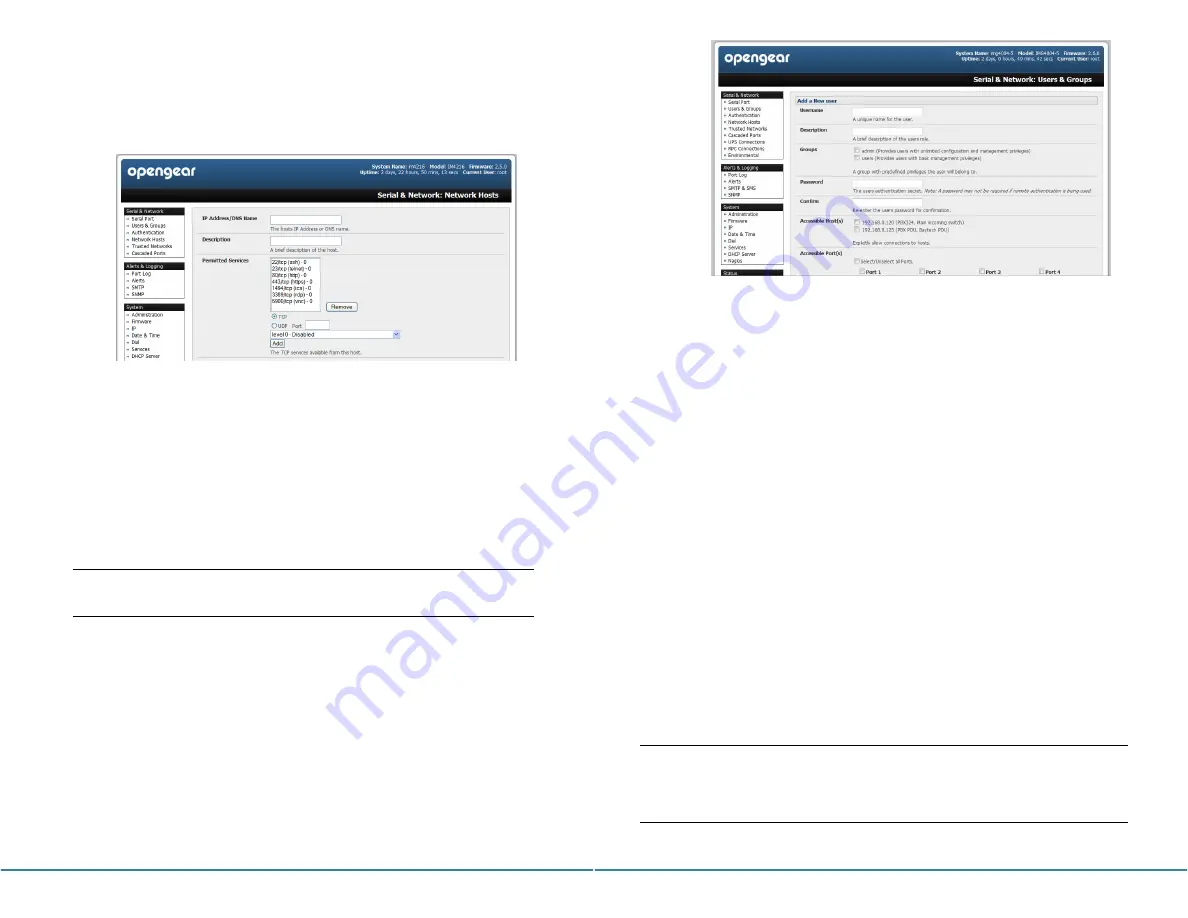
IM42xx-2 Quick Start (Rev 3.1)
Page 3
A
Logging Level
may also be set to
specify the level of information to be
logged and monitored for the serial port
Click
Apply
To enable access through the console server to a locally networked computer
(referred to as a
host), select
Serial & Network: Network Hosts
and click
Add Host
Enter the
IP address/DNS Name
of the host
Edit the
Permitted Services
used for accessing this host, e.g. HTTPS (TCP
port 443), VNC (TCP port 5900), or add custom TCP or UDP port numbers – only
the services specified here are tunneled through to the host, all other services
are blocked
At this stage you may also specify the level of information to be logged and
monitored for each host access
Click
Apply
Step 5
Add new users
Note:
It is recommended that you set up a new Administrator user (in the
admin
group with full access privileges) and login as this new user for all ongoing
administration functions (rather than continuing as
root)
For each new user, select
Serial & Network: Users & Groups
and click
Add
User
Enter a
Username
and enter and confirm a
Password
,
and nominate the
Accessible Hosts
and
Accessible Ports
the user is allowed to access
To grant limited access to the Management Console, check the
user
Group
, to
grant full access to the Management Console, check the
admin
Group
– by
default the user is granted no Management Console access
IM42xx-2 Quick Start (Rev 3.1)
Page 4
Click
Apply
Step 6
Advanced configurations
The console server offers many more advanced functions including:
The
Alerts & Logging: Alerts
facility
monitors serial ports, hosts, user logins,
UPSes (Uninterruptible Power Supplies), RPCs (Remote Power Controllers, such as
PDUs and IPMI devices) and EMDs (Environmental Monitoring Devices). A broad
selection of trigger events (such data patterns, temperature or battery levels) can
be specified. When triggered, a warning email, SMS,
Nagios or SNMP alert is sent
to a nominated destination.
Extensive management of UPSes and RPCs using open source
NUT and Powerman
tools. The
Manage: Power
facility enables both administrators and regular users
to monitor and control attached PDU power strips, and servers with embedded
IPMI BMCs.
Connect EMDs to any serial port (with an adapter) and remotely monitor the
temperature, humidity, physical access, smoke alarms, etc. Details are provided in
the
EMD5000 Quick Start supplied with the EMD.
Historical logs of all communications with serial and network attached devices,
system activity, UPS and PDU power status, environmental status, etc. The level of
logging is set as ports and devices are configured,
Alerts & Logging: Port Log
allows this history to be saved locally or remotely. Logs can be viewed from the
Status
and
Manage
menus.
Other advanced features, such as
Serial Port Cascading, remote Authentication,
Trusted Networks, Secure Tunneling, Nagios Distributed Monitoring, the Command
Line interface – these are covered in detail in the User Manual on the CDROM.
Note:
On the CDROM you will also find the SDT Connector software tool. Once you
have configured the console server, this tool provides you with secure, point and
click access to the console server and all the attached devices.
Refer to the
provided
SDTConnector Quick Start for details on setting up remote
management of the console server and connected devices.


